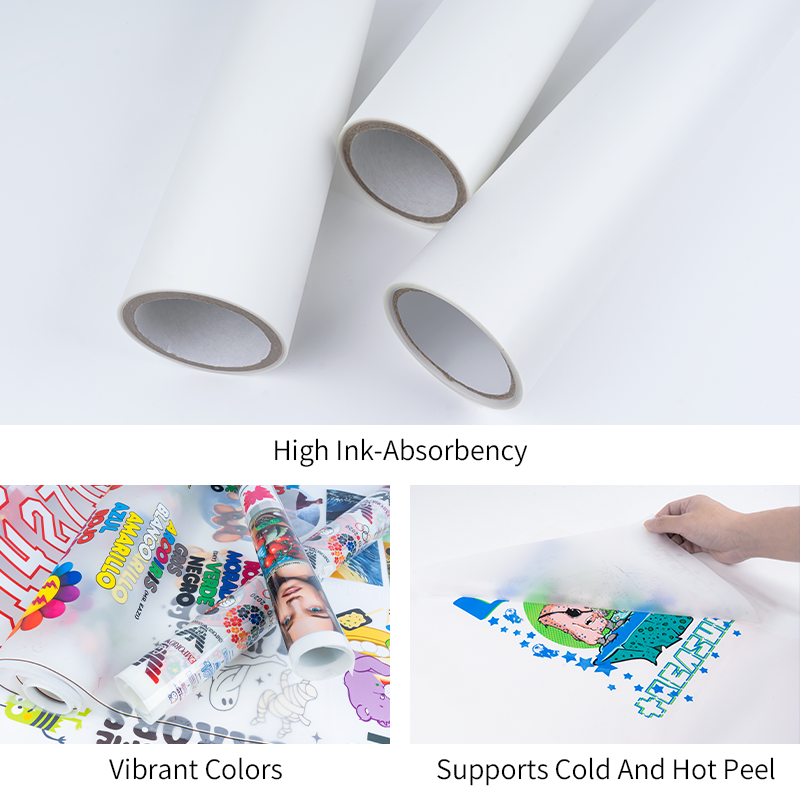ປະສິດແມ່ນມີຜົນການຕໍ່ຄຸນພາບຂອງການພິມ DTF ມີຫຍັງ
ການເຂົ້າໃຈຜົນການຂອງປະສິດຕໍ່ການພິມ DTF (Direct-to-Film) ແມ່ນສຳຄັນສູງສຸດເພື່ອຮັກษาຄຸນພາບແລະຄວາມຖືກຕ້ອງຂອງການພິມ. ຕັ້ງແຕ່ຄວາມໝັ້ນຂອງຟິມໄປໜ້າກັບການຊຸມຂອງພ້ອວເດີ, ຄວາມສູງຂອງປະສິດມີຄວາມທັນທີ່ຫຼາຍທີ່ຕ້ອງການການແກ້ໄຂເພື່ອສົ່ງຜົນທີ່ດີທີ່ສຸດ.
ຄວາມໝັ້ນຂອງຟິມແລະຄວາມຫຍຸ້ງຍາກໃນການຈັດການ
ຄວາມຊື້ນສູງສົ່ງຜົນກະທົບຕໍ່ແຜ່ນ DTF ໂດຍເຮັດໃຫ້ມັນນຸ່ມກວ່າປົກກະຕິ, ເຊິ່ງເຮັດໃຫ້ເກີດບັນຫາຕ່າງໆໃນຂະນະທີ່ຈັດການໃນຂະບວນການຜະລິດ. ວັດສະດຸທີ່ນຸ່ມລົງບໍ່ສາມາດຮັກສາຄຸນນະພາບໄດ້ດີ, ສະນັ້ນມີໂອກາດທີ່ຈະຂາດຫຼືບໍ່ຖືກຕ້ອງໃນຂະນະທີ່ກຳລັງໂອນແຜ່ນ. ການດູດຊຶມເອົາຄວາມຊື້ນເປັນບັນຫາທີ່ສຳຄັນສຳລັບຜູ້ປະຕິບັດງານທີ່ພະຍາຍາມຈັດຕຳແໜ່ງໃຫ້ຖືກຕ້ອງໃນມື້ທີ່ພິມ, ເນື່ອງຈາກວ່າການເຄື່ອນຍ້າຍເລັກນ້ອຍໆກໍສາມາດເຮັດໃຫ້ເກີດຂໍ້ບົກຜ່ອງໃນການພິມໄດ້. ທຸກຄົນທີ່ເຮັດວຽກໃນສະຖານທີ່ທີ່ຄວາມຊື້ນສູງເກີນ 60% ຢ່າງຕໍ່ເນື່ອງຮູ້ຈາກປະສົບການໂຕຈິງ. ແຜ່ນເລີ່ມບິດເບືອນໃນເງື່ອນໄຂດັ່ງກ່າວ, ສະນັ້ນຜູ້ຜະລິດຈຳເປັນຕ້ອງມີນະໂຍບາຍທີ່ເຂັ້ມງວດກ່ຽວກັບການຄວບຄຸມອຸນຫະພູມ ແລະ ວິທີການເກັບຮັກສາເພື່ອຫຼີກລ່ຽງການເຮັດວຽກຄືນໃໝ່ທີ່ເສຍຄ່າໃຊ້ຈ່າຍໃນອະນາຄົດ.
ການຍ້າຍແລະຄວາມບໍ່ຄົບຄຸນ
ເມື່ອຄວາມຊື້ນສູງເກີນໄປ, ແຜ່ນ DTF ມັກຈະມ້ວນເຂົ້າຫາກັນເອງ, ສິ່ງນີ້ເຮັດໃຫ້ເກີດບັນຫາຫຼາຍຢ່າງໃນຂະນະທີ່ຈະປັ້ນຖ່າຍຮູບພາບ. ແຜ່ນທີ່ມ້ວນຈະບໍ່ສາມາດຈັດຕຳແໜ່ງໄດ້ຖືກຕ້ອງ, ແລະ ສິ່ງນີ້ກໍເຮັດໃຫ້ສີສັນບໍ່ຖືກຕ້ອງໃນຂະນະທີ່ພິມ. ສິ່ງທີ່ເຮົາໄດ້ຮັບຄືການພິມທີ່ສີແດງອາດຈະເປັນສີມ່ວງ ຫຼື ສີຟ້າອາດຈະເປັນສີຂຽວ. ຕາມການຄົ້ນຄວ້າຂອງອຸດສະຫະກຳບາງຢ່າງ, ຜູ້ຜະລິດລາຍງານວ່າມີບັນຫາການຈັດຕຳແໜ່ງຫຼາຍຂຶ້ນປະມານ 30% ເມື່ອເຮັດວຽກກັບວັດຖຸດິບທີ່ມີຄວາມຊື້ນ. ນັ້ນແມ່ນເຫດົດຜົນທີ່ຮ້ານຫຼາຍແຫ່ງລົງທຶນໃນລະບົບຄວບຄຸມອາກາດໃນເຂດພິມໃນປັດຈຸບັນ. ການຮັກສາໃຫ້ສະຖານທີ່ແຫ້ງແມ່ນບໍ່ພຽງແຕ່ຫຼີກລ່ຽງການສູນເສຍວັດຖຸດິບເທົ່ານັ້ນ, ແຕ່ຍັງຊ່ວຍປະຢັດເວລາ ແລະ ເງິນໃນໄລຍະຍາວ.
ການຮັບຄວາມຊຸມໃນDTF Powder
ຄວາມຊື້ນໃນອາກາດສົ່ງຜົນກະທົບຕໍ່ຜົງ DTF ເນື່ອງຈາກມັນມັກດູດຊື້ນແລ້ວກ້າຍເປັນກ້ອນ. ເມື່ອເກີດເຫດການນີ້ ຜົງຈະບໍ່ຕິດກັບພື້ນຜິວຂອງແຜ່ນໄດ້ດີ. ຜົນໄດ້ຮັບແມ່ນຊັ້ນຄຸນນະພາບບໍ່ສະເໝີພາບ ເຊິ່ງເຮັດໃຫ້ການພິມເບິ່ງບໍ່ດີ ແລະ ກາຍເປັນເຫດຜົນໃຫ້ການພິມບໍ່ສາມາດຢູ່ໄດ້ດົນເທົ່າທີ່ຄວນ. ພາຍໃນອຸດສາຫະກໍາ ພວກເຂົາເຈົ້າໄດ້ພົບເຫັນບັນຫາທີ່ຜົງທີ່ຖືກເປີຍນ້ຳສູນເສຍປະສິດທິພາບການຖ່າຍໂອນລົງເຖິງປະມານ 20% ໃນສະພາບການເກັບຮັກສາ ຫຼື ການພິມທີ່ບໍ່ເໝາະສົມ. ບັນຫານີ້ສາມາດເພີ່ມຂື້ນໄດ້ຢ່າງໄວວາໃນສະພາບແວດລ້ອມການຜະລິດທີ່ຄວາມສອດຄ່ອງເປັນສິ່ງສຳຄັນທີ່ສຸດ.
ເວລາການແຜ່ດັບຫຼາຍຂື້ນແລະຄວາມເສຍທີ່ຈຳກັດ
ລະດັບຄວາມຊື້ນສູງສາມາດສົນທະນາກັບເວລາແຫ້ງເມື່ອໃຊ້ຮ່ວມກັບໝຶກໃນເມັດ DTF, ສະນັ້ນການຜະລິດກໍ່ຈະຊ້າລົງ ແລະ ຄ່າໃຊ້ຈ່າຍກໍ່ຈະເພີ່ມຂື້ນສຳລັບຜູ້ຜະລິດ. ເມື່ອໝຶກແຫ້ງຊ້າເກີນໄປ, ມັນກໍ່ຈະບໍ່ຕິດກັບພື້ນຜິວຜ້າໄດ້ດີພຽງພໍ. ພວກເຮົາໄດ້ເຫັນບາງກໍລະນີທີ່ຄວາມຊື້ນສາມາດເພີ່ມເວລາແຫ້ງເປັນສອງເທົ່າຂອງເວລາປົກກະຕິ, ສ້າງຄວາມເຈັບຫົວໃຫຍ່ໃນການຄຸ້ມຄອງຂະບວນການຜະລິດ. ສຳລັບໃຜກໍຕາມທີ່ດຳເນີນທຸລະກິດຮ້ານພິມ, ການຄວບຄຸມຄວາມຊື້ນບໍ່ພຽງແຕ່ເປັນການປະຕິບັດທີ່ດີເທົ່ານັ້ນ, ແຕ່ຍັງເປັນສິ່ງຈຳເປັນຫຼາຍຖ້າພວກເຂົາຕ້ອງການໃຫ້ການດຳເນີນງານຂອງພວກເຂົາດຳເນີນໄປໂດຍບໍ່ມີການຢຸດເຊົາຕະຫຼອດເວລາ ຫຼື ມີບັນຫາດ້ານຄຸນນະພາບຕາມມາ.
ຄຸນສຸພັດທີ່ສຳຄັນຂອງຟິນ DTF ທີ່ກັບຄວາມຊຸມຊົງ
ສູດພອລີມີນຫຼັງຄືກັບນ້ຳ
ແຜ່ນ DTF ທີ່ຕ້ານທານຄວາມຊື້ນໄດ້ດີເຮັດວຽກໄດ້ຍ້ອນມັນມີໂພລີເມີ hydrophobic ພິເສດທີ່ຊ່ວຍເຮັດໃຫ້ນ້ຳຖືກດັນອອກໄປ ແລະ ລົດບັນຫາທີ່ເກີດຈາກຄວາມຊຸ່ມ ຊຶ່ງເຮັດໃຫ້ງານພິມຍັງຮັກສາຄຸນນະພາບໄດ້ດີເຖິງແມ່ນວ່າອາກາດຈະຮ້ອນຊື່ມ. ໂພລີເມີເອງກໍເປັນສານທີ່ດີເລີດຫຼາຍ. ມັນຍັງຊ່ວຍໃຫ້ແຜ່ນມີອາຍຸຍືນ ແລະ ປະຕິບັດງານໄດ້ດີຂື້ນອີກດ້ວຍ ສະນັ້ນຜູ້ທີ່ພິມຈຶ່ງບໍ່ຕ້ອງກັງວົນກ່ຽວກັບອາກາດບໍ່ດີທີ່ອາດຈະເຮັດໃຫ້ງານພິມເສຍຫາຍໄດ້. ການທົດສອບບາງຢ່າງສະແດງໃຫ້ເຫັນວ່າຊັ້ນຄຸ້ມພິເສດເຫຼົ່ານີ້ສາມາດຕ້ານກັນຄວາມຊື້ນໄດ້ຫຼາຍກ່ວາແຜ່ນທົ່ວໄປເຖິງ 90%, ເຊິ່ງເຮັດໃຫ້ຄວາມແຕກຕ່າງໃນການຮັກສາງານພິມໃຫ້ຊັດເຈນໃນໄລຍະຍາວ. ສຳລັບຜູ້ໃດທີ່ເຮັດ DTF ແລະ ຄວາມຊື້ນເປັນບັນຫາຕະຫຼອດເວລາ, ເທກໂນໂລຊີນີ້ແທ້ຈິງເຮັດໃຫ້ທຸກຢ່າງດີຂື້ນຫຼາຍ.
ເทັກນົອລົກການປ້ອງກັນຄວາມຊຸ້ມແຫ່ງແวดລ໌
ເทກໂນໂລຊີກັ້ນທີ່ທັນສະໄໝທີ່ໃຊ້ໃນຮູບແບບ DTF ກັນຊື້ນ ສາມາດປ້ອງກັນຄວາມຊື້ນຈາກສະພາບແວດລ້ອມໄດ້ ເຊິ່ງຊ່ວຍຮັກສາຄວາມງາມຂອງສິ່ງທີ່ພິມໄວ້ໃນທຸກສະພາບອາກາດ. ລະບົບສ່ວນຫຼາຍໃຊ້ຊັ້ນສານປົກປ້ອງຫຼາຍຊັ້ນເພື່ອບໍ່ໃຫ້ນ້ຳຊຶມເຂົ້າໃນວັດສະດຸ ເຊິ່ງຈະເຮັດໃຫ້ຮູບພິມເສຍຫາຍຖ້າບໍ່ໄດ້ຮັບການຄວບຄຸມ. ຕາມຄົນທີ່ເຮັດວຽກກັບວັດສະດຸເຫຼົ່ານີ້ເປັນປະຈຳ ການເພີ່ມຊັ້ນກັ້ນດັ່ງກ່າວສາມາດເຮັດໃຫ້ເຫັນຄວາມແຕກຕ່າງໄດ້ຢ່າງຈະແຈ້ງເປັນເວລາຍາວ ໂດຍສະເພາະໃນບັນດາສະຖານທີ່ທີ່ມີຄວາມຊື້ນສູງຕະຫຼອດເວລາ. ເມື່ອຜູ້ຜະລິດອອກແບບຊັ້ນປົກປ້ອງເຫຼົ່ານີ້ເຂົ້າໄປໃນຜະລິດຕະພັນຂອງເຂົາເຈົ້າ ຜົນທີ່ໄດ້ຄືການຜະລິດຮູບແບບທີ່ສາມາດຮັກສາຄຸນສົມບັດດັ້ງເດີມໄວ້ໄດ້ ເຖິງແມ່ນວ່າຈະຖືກສຳຜັດກັບສະພາບແວດລ້ອມທີ່ຮຸນແຮງເປັນເວລາດົນນານກໍ່ຕາມ.
ຄວາມສະເສີມສະຫຼາຍ ກາຍຫຼາຍ ໃນສະຖານະທີ່ຊຸມ
ແຜ່ນ DTF ທີ່ຖືກອອກແບບມາໃຫ້ຕ້ານທານຄວາມຊື້ນ ມີຄວາມສະຖຽນລະພາບດ້ານມິຕິດີຂຶ້ນ ເຊິ່ງຊ່ວຍຫຼຸດບັນຫາການຜິດຮູບພາຍໃນເຂດທີ່ມີຄວາມຊື້ນສູງ. ສິ່ງນີ້ສຳຄັນຫຼາຍຕໍ່ການໄດ້ສີທີ່ຖືກຕ້ອງ ແລະ ການຈັດຕຳແໜ່ງໃນຂະນະທີ່ພິມ. ເມື່ອພິມແລ້ວ ແຜ່ນທີ່ສະຖຽນນີ້ຍັງຄົງຮູບແບບດຽວ ແລະ ບໍ່ມີການມ້ວນ ຫຼື ເຄື່ອນຍ້າຍເຊັ່ນທີ່ແຜ່ນທຳມະດາມັກເຮັດ. ການທົດສອບສະແດງໃຫ້ເຫັນວ່າມັນສາມາດຕ້ານທານສະພາບທີ່ຫຍຸ້ງຍາກໄດ້ດີເຊັ່ນກັນ. ໃນການທົດສອບໃນຫ້ອງທົດລອງທີ່ 85% ຄວາມຊື້ນໃນໄລຍະຫຼາຍມື້ ແຜ່ນທີ່ກັນນ້ຳເຫຼືອນຮູບພາຍໃນ 5% ໃນຂະນະທີ່ແຜ່ນມາດຕະຖານມັກຈະບິດເສຍຮູບທັງໝົດ. ສຳລັບຮ້ານພິມທີ່ປະເຊີນກັບສະພາບອາກາດທີ່ຊຸ່ມ ຫຼື ຄວາມຊື້ນທີ່ປ່ຽນແປງຕາມລະດູການ ການລົງທຶນໃນແຜ່ນພິເສດເຫຼົ່ານີ້ເປັນເລື່ອງສົມເຫດສົມຜົນຖ້າຄຸນນະພາບຂອງຜົນໄດ້ຮັບເປັນສິ່ງສຳຄັນ.
ຄົບຄ້າກັບການພິມໃນສະຖານທີ່ຊຸມສູງ
ວັດສະດຸທີ່ໃຊ້ໃນການນໍາໃຊ້ເຫຼົ່ານີ້ ໄດ້ຖືກພັດທະນາຂຶ້ນໂດຍສະເພາະເພື່ອໃຫ້ເຮັດວຽກໄດ້ດີໃນສະພາບແວດລ້ອມທີ່ມີຄວາມຊຸ່ມຊື່ນສູງ. ວັດສະດຸເຫຼົ່ານີ້ຍັງສາມາດເຮັດວຽກໄດ້ດີເຖິງແມ່ນວ່າຈະຖືກສໍາຜັດກັບຄວາມຊຸ່ມຊື່ນຫຼາຍ. ການແກ້ໄຂບັນຫານີ້ໃຫ້ຖືກຕ້ອງເປັນສິ່ງສໍາຄັນຍ້ອນມັນສົ່ງຜົນຕໍ່ຄວາມສອດຄ່ອງຂອງຜົນໄດ້ຮັບໃນການພິມ. ບັນຫາຄວາມຊຸ່ມຊື່ນສາມາດເຮັດໃຫ້ເກີດບັນຫາຕ່າງໆໃນຂະນະການພິມ, ສະນັ້ນການໃຊ້ວັດສະດຸທີ່ຕ້ານທານຄວາມຊຸ່ມຊື່ນຈຶ່ງຊ່ວຍຫຼີກເວັ້ນບັນຫາເຫຼົ່ານັ້ນ. ຜູ້ຜະລິດເຊື່ອວ່າ ການປ່ຽນມາໃຊ້ວັດສະດຸທີ່ຕ້ານທານຄວາມຊຸ່ມຊື່ນສາມາດຫຼຸດຜ່ອນບັນຫາໃນຂະບວນການຜະລິດລົງໄດ້ປະມານ 40% ໃນສະພາບແວດລ້ອມທີ່ມີຄວາມຊຸ່ມຊື່ນສູງ. ສໍາລັບບໍລິສັດທີ່ດໍາເນີນການພິມໂດຍກົງລົງໃນວັດສະດຸ, ການເລືອກຊະນິດວັດສະດຸທີ່ເໝາະສົມເປັນສິ່ງສໍາຄັນຫຼາຍ, ໂດຍສະເພາະຖ້າຫ້ອງທົດລອງຂອງພວກເຂົາມີຄວາມຊຸ່ມຊື່ນເປັນປະຈໍາ.
ຄວາມສຳເລັດເทັກນິກໃນສະຖານທີ່ທີ່ມີຄວາມຊຸມ
ການປ້ອງກັນມັກການລະເອີນແລະການລົ້ມວິ_theta
ແຜ່ນ DTF ທີ່ຕ້ານທານຄວາມຊື້ນມີຄວາມສຳຄັນຫຼາຍໃນການຢຸດການໄຫຼຂອງໝຶກໃນສະພາບແວດລ້ອມທີ່ຊຸ່ມ ເຊິ່ງຊ່ວຍຮັກສາສີສັນໃຫ້ເບິ່ງເປັນທຳມະຊາດ. ສິ່ງທີ່ເຮັດໃຫ້ມັນມີປະສິດທິພາບແມ່ນການກຳຈັດການແຜ່ຂອງໝຶກໃນພື້ນຜິວ ຊຶ່ງຮັກສາທັງຄວາມສົດໃສດແລະຄວາມຊັດເຈນທີ່ຈຳເປັນຕໍ່ການພິມທີ່ດີ. ການຄົ້ນຄວ້າບາງຢ່າງໄດ້ຊີ້ໃຫ້ເຫັນວ່າ ແຜ່ນພິເສດເຫຼົ່ານີ້ສາມາດຫຼຸດບັນຫາການໄຫຼຂອງໝຶກລົງໄດ້ປະມານ 25% ເມື່ອທຽບກັບແຜ່ນທົ່ວໄປທີ່ມີໃນຕະຫຼາດປັດຈຸບັນ. ນັ້ນໝາຍເຖິງການພິມທີ່ຍືນຍົງຍາວນານຂຶ້ນ ແລະ ລວມເຖິງຮູບລັກສະນະທີ່ດີຂຶ້ນອີກດ້ວຍ. ຮ້ານພິມທີ່ຕ້ອງການຜົນໄດ້ຮັບທີ່ເຊື່ອຖືໄດ້ຄວນພິຈາລະນາການປ່ຽນມາໃຊ້ແຜ່ນທີ່ຕ້ານທານຄວາມຊື້ນ. ແນ່ນອນວ່າມັນມີຄ່າໃຊ້ຈ່າຍເບື້ອງຕົ້ນ, ແຕ່ຫຼາຍຄົນກໍພົບວ່າມັນຄຸ້ມຄ່າໃນໄລຍະຍາວ ເນື່ອງຈາກການຫຼຸດຜ່ອນຜົນພິມທີ່ເສຍຫາຍ ແລະ ລູກຄ້າທີ່ພໍໃຈໃນຄຸນນະພາບທີ່ເຫັນໄດ້.
ການຮັກษาຄວາມສາມານຍິດຂອງຟິມສໍາລັບການຈັບຄູ່ຢ່າງແນ້ວໝາຍ
ການຮັກສາຮູບເງົາໃຫ້ສະເໝີພາວະເມື່ອລະດັບຄວາມຊື້ນເພີ່ມຂື້ນຍັງຄົງເປັນສິ່ງສຳຄັນເພື່ອໃຫ້ໄດ້ຮັບການຈັດຕຳແໜ່ງທີ່ດີ ແລະ ຜະລິດສິ່ງພິມທີ່ມີຄຸນນະພາບ. ຮູບເງົາ DTF ທີ່ຕ້ານທານຄວາມຊື້ນເຮັດວຽກໄດ້ດີຫຼາຍໃນການຮັກສາຄວາມສະເໝີພາວະໃນຂະນະທີ່ຂະບວນການພິມດຳເນີນໄປ, ຊຶ່ງຊ່ວຍປ້ອງກັນບັນຫາການຈັດຕຳແໜ່ງທີ່ເຮັດໃຫ້ຄວາມຖືກຕ້ອງຂອງການພິມເສຍຫາຍ. ຮ້ານພິມຈຳນວນຫຼາຍໄດ້ລາຍງານວ່າຮູບເງົາເຫຼົ່ານີ້ສາມາດຮັກສາຄວາມສະເໝີພາວະໄດ້ພາຍໃນຂອບເຂດປະມານ 0.1 ມິນລີແມັດ, ສິ່ງທີ່ເຮັດໃຫ້ຄວາມແຕກຕ່າງໃນຄຸນນະພາບຂອງຜະລິດຕະພັນສຸດທ້າຍ. ສຳລັບບໍລິສັດທີ່ດຳເນີນງານຢູ່ໃນສະພາບແວດລ້ອມທີ່ມີຄວາມຊື້ນສູງ ຫຼື ພື້ນທີ່ທີ່ມີຮູບແບບອາກາດທີ່ປ່ຽນແປງ, ການລົງທຶນໃນວັດສະດຸທີ່ກັນຄວາມຊື້ນໄດ້ໃຫ້ຜົນຕອບແທນທີ່ດີ. ບໍ່ພຽງແຕ່ຊ່ວຍປະຢັດເວລາທີ່ໃຊ້ໃນການແກ້ໄຂສິ່ງພິມທີ່ບໍ່ຖືກຕ້ອງເທົ່ານັ້ນ, ແຕ່ຍັງໝາຍເຖິງວັດສະດຸທີ່ຖືກຂວ້າໂລກໜ້ອຍລົງ ແລະ ລູກຄ້າທີ່ພໍໃຈຍ້ອນໄດ້ຮັບຜະລິດຕະພັນທີ່ພິມມາດ້ວຍຄວາມຊັດເຈນຕະຫຼອດເວລາເຖິງແມ້ກະທັ້ງສະພາບການບໍ່ດີ.
ການຕ້ອງກັບການເພີ່ມຂຶ້ນຂອງເຫຼືອງຊີວະໃນສະຖານະທີ່ມີຄວາມຊຸມ
ແຜ່ນ DTF ທີ່ຕ້ານທານຄວາມຊື້ນສາມາດຕ້ານການເຕີບໂຕຂອງຈຸລິນຊີໄດ້ດີ, ເຊິ່ງເປັນບັນຫາໃນບັນດາບ່ອນທີ່ມີຄວາມຊື້ນສູງເຊິ່ງພິມອອກມາຈະເລີ່ມເສື່ອມສະພາບໄປຕາມເວລາ. ຜູ້ຜະລິດສ່ວນຫຼາຍຈະປິ່ນປົວແຜ່ນເຫຼົ່ານີ້ດ້ວຍສານເພີ່ມພິເສດທີ່ສາມາດຢຸດການເຕີບໂຕຂອງຈຸລິນຊີໄດ້ປະມານ 99 ເປີເຊັນ, ສະນັ້ນຮູບພິມຈຶ່ງສາມາດຮັກສາຄວາມງາມໄດ້ດົນກວ່າວັດສະດຸທົ່ວໄປ. ການປົກປ້ອງນີ້ຊ່ວຍຮັກສາຄວາມສົດໃສຂອງສີສັນ ແລະ ລາຍລະອຽດໃຫ້ຊັດເຈນເຖິງແມ້ນວ່າຈະຖືກວາງໃນສະພາບແວດລ້ອມເປີດເຜີຍເປັນເວລາຫຼາຍເດືອນ. ຮ້ານພິມ ແລະ ຜູ້ຜະລິດຜະລິດຕະພັນທີ່ໃຫ້ຄຸນຄ່າກັບຄວາມຖືກຕ້ອງສອດຄ່ອງຂອງຜົນໄດ້ຮັບຄວນພິຈາລະນາເລືອກວັດສະດຸນີ້ເຂົ້າໃນການຕັດສິນໃຈເມື່ອເຮັດວຽກໃນສະຖານທີ່ທີ່ມີຄວາມຊື້ນສູງ.
ຄວາມສະຖິລທີ່ຮ້ອນໃນການໂຫຼ້າການຮ້ອນ
ຂໍ້ດີໃຫຍ່ອັນໜຶ່ງຂອງເທືອກ DTF ກັນຊື້ນແມ່ນຢູ່ທີ່ຄວາມສະຖຽນທາງຄວາມຮ້ອນຂອງມັນ ໂດຍສະເພາະເວລາໃຊ້ໃນການໂອນຮ້ອນ. ວັດຖຸດິບເຫຼົ່ານີ້ຍັງສາມາດຕ້ານທານກັບອຸນຫະພູມສູງໄດ້ດີ ປະມານ 200 ອົງສາເຊີນໄດ້ເຊັ່ນກັນ ສະນັ້ນແລ້ວຮູບພິມຈະຍັງຄົງຢູ່ໃນສະພາບດີຕະຫຼອດຂະບວນການໃຫ້ຄວາມຮ້ອນ. ສິ່ງທີ່ເປັນປະໂຫຍດໃນການປະຕິບັດແມ່ນຮູບພິມຈະບໍ່ເສຍຮູບ ຫຼື ບິດເບືອນ ຊຶ່ງຊ່ວຍຮັກສາຄຸນນະພາບຂອງຮູບພິມໃຫ້ຍັງງາມຢູ່ເຖິງເວລາທີ່ມັນຮ້ອນ. ສໍາລັບບໍລິສັດທີ່ນໍາໃຊ້ເທືອກເຫຼົ່ານີ້ໃນແຕ່ລະມື້ໃນແຖວຜະລິດຂອງເຂົາເຈົ້າ, ມີໂອກາດໜ້ອຍລົງທີ່ຈະມີຮູບພິມທີ່ຜິດພາດອອກມາໃນຜະລິດຕະພັນສໍາເລັດຮູບ. ສິ່ງນີ້ກໍເຮັດໃຫ້ຜົນຜະລິດທີ່ຖືກປະຕິເສດໜ້ອຍລົງ ການດໍາເນີນງານມີປະສິດທິພາບດີຂຶ້ນ ແລະ ສຸດທ້າຍແລ້ວກໍເຮັດໃຫ້ລູກຄ້າພໍໃຈຍິ່ງຂຶ້ນເມື່ອໄດ້ຮັບສິ່ງທີ່ເຂົາເຈົ້າສັ່ງໂດຍບໍ່ມີບັນຫາ
ຂໍ້ມູນການຈັດການອາກາດ
ການຄວບຄຸມສະພາບອາກາດໃນເຂດພິມໃຫ້ດີແມ່ນມີຄວາມສຳຄັນຫຼາຍໃນການຈັດການຄວາມຊື້ນໃຫ້ເໝາະສົມ. ສ່ວນຫຼາຍແລ້ວ, ການພິມຈະຕ້ອງຮັກສາຄວາມຊື້ນໃນລະດັບປະມານ 40 ຫາ 60% ຖ້າຕ້ອງການໃຫ້ຜົນໄດ້ພິມອອກມາດີແລະສອດຄ່ອງກັນ. ເມື່ອສະພາບແວດລ້ອມຢູ່ໃນຂອບເຂດນີ້, ບັນຫາຕ່າງໆ ເຊັ່ນ: ຜົງສີຈັບຕົວເປັນກ້ອນ ຫຼື ຈຸດດຳທີ່ເກີດຈາກການແຈກຢາຍບໍ່ສະເໝີນັ້ນຈະຫຼຸດລົງໃນຂະນະທີ່ພິມດ້ວຍເຕັກໂນໂລຊີ DTF. ຕາມທີ່ມາດຕະຖານຂອງອຸດສະຫະກຳໄດ້ລະບຸໄວ້, ການຄຸ້ມຄອງສະພາບອາກາດໃຫ້ເໝາະສົມສາມາດເພີ່ມຄຸນນະພາບຂອງການພິມໃຫ້ດີຂື້ນໄດ້ປະມານ 30%. ແລະຄົນໃດກໍບໍ່ຢາກສູນເສຍວັດຖຸດິບໃນການຜະລິດຊິ້ນງານທີ່ບໍ່ດີ. ການຮັກສາຄວາມຊື້ນໃຫ້ຢູ່ໃນຂອບເຂດທີ່ເໝາະສົມຍັງຊ່ວຍຮັກສາຄຸນນະພາບຂອງ DTF films ໄວ້ໄດ້ດີ, ສະນັ້ນຜູ້ປະຕິບັດງານຈະໄດ້ຜົນໄດ້ທີ່ດີໂດຍບໍ່ຕ້ອງປັບຕັ້ງຄ່າຕະຫຼອດເວລາ ຫຼື ຈັດການກັບວັດຖຸດິບທີ່ຖືກທິ້ງເສຍຫຼາຍເກີນໄປ.
ພື້ນຖານການໂຫຼາຍຄວາມຊຸມສໍາລັບສະຖານພິມ
ການຕັ້ງຄ່າການຕິດຕາມຄວາມຊື້ນໃນຮ້ານພິມໃຫ້ຖືກຕ້ອງ ຈະຊ່ວຍໃຫ້ພວກເຮົາສາມາດຄົ້ນພົບບັນຫາຄວາມຊື້ນໄດ້ຕັ້ງແຕ່ເນີຍກ່ອນທີ່ມັນຈະເລີ່ມສົນທະນາກັບຄຸນນະພາບການພິມ. ເມື່ອພວກເຮົາກວດສອບລະດັບຄວາມຊື້ນເປັນປະຈຳ ພວກເຮົາສາມາດປັບປຸງແຜນການຜະລິດ ແລະ ຈັດການວັດຖຸດິບໄດ້ດີຂຶ້ນ ເພື່ອຮັກສາຄຸນນະພາບການພິມໃຫ້ຄົງທີ່. ສ່ວນຫຼາຍແລ້ວຄູ່ມືຂອງອຸດສະຫະກຳແນະນຳໃຫ້ກວດສອບຢ່າງໜ້ອຍຊົ່ວໂມງລະ1ຄັ້ງ ໂດຍສະເພາະໃນບັນດາພື້ນທີ່ທີ່ມີຄວາມຊື້ນໃນອາກາດສູງ. ຄວາມຈິງແລ້ວ ເມື່ອເງື່ອນໄຂມີການປ່ຽນແປງຢ່າງໄວວາການກວດສອບເປັນປະຈຳເຫຼົ່ານີ້ຈະເຮັດໃຫ້ມີຄວາມແຕກຕ່າງ. ພວກເຮົາໄດ້ເຫັນດ້ວຍຕົນເອງວ່າ ການຕິດຕາມກວດກາຄວາມຜັນຜວນຂອງຄວາມຊື້ນຢູ່ສະເໝີ ຈະຊ່ວຍຮັກສາເຄື່ອງພິມໃຫ້ດຳເນີນໄປຢ່າງລຽນລ້ຳ ແລະ ປ້ອງກັນບັນຫາຄຸນນະພາບທີ່ຫຍຸ້ງຍາກເຊິ່ງບໍ່ມີໃຜຢາກໃຫ້ເກີດຂຶ້ນໃນຂະນະທີ່ກຳລັງເຮັດວຽກໃນເວລາທີ່ກົດດັນສູງ.

Wiązານິຍົມການຫຼຸດຄວາມຊຸມ
ການເພີ່ມລະບົບດູດຊື້ນທີ່ເຊື່ອມໂຍງເຂົ້າກັບຂະບວນການພິມ ຈະຊ່ວຍຄວບຄຸມລະດັບຄວາມຊື້ນຕະຫຼອດຂະບວນການຜະລິດ. ລະບົບເ arthົ່ງນີ້ເຮັດວຽກທັງມື້, ສະນັ້ນສິ່ງຕ່າງໆຈຶ່ງແຫ້ງພຽງພໍເພື່ອໃຫ້ວຽກພິມອອກມາດີ ແລະ ບໍ່ເສຍຮູບ ຫຼື ສົມທິ້ງ. ບາງລາຍງານຂອງອຸດສາຫະກຳສະແດງໃຫ້ເຫັນວ່າ ທຸລະກິດທີ່ຫຼຸດຄວາມຊື້ນ ສາມາດຫຼຸດການສູນເສຍວັດຖຸດິບໄດ້ຫຼາຍເຖິງປະມານ 25% ທຽບກັບກ່ອນທີ່ຈະຕິດຕັ້ງລະບົບເຫຼົ່ານີ້. ການປະຢັດແບບນີ້ຈະເພີ່ມຂື້ນຕາມການເວລາ ແລະ ຍັງຮັບປະກັນໃຫ້ຜະລິດຕະພັນພິມຕອບສະໜອງມາດຕະຖານຄຸນນະພາບ ໂດຍສະເພາະແມ່ນສຳລັບວຽກທີ່ລະອຽດເຊັ່ນການໂອນພິມໂດຍກົງລົງໃນຮູບເງົາ (Direct to Film Transfers) ເຊິ່ງຄວາມຊື້ນເລັກນ້ອຍໆກໍສາມາດເຮັດໃຫ້ຜົນງານສຸດທ້າຍເສຍຫາຍໄດ້ທັງໝົດ.
ພື້ນຖານກ່ອນພິມສໍາລັບວັດຖຸ
ການກຽມວັດຖຸດິບໃຫ້ພ້ອມກ່ອນການພິມ ຈະເຮັດໃຫ້ຜົນໄດ້ຮັບດີຂື້ນຫຼາຍເມື່ອເຮັດວຽກໃນສະພາບແວດລ້ອມທີ່ມີຄວາມຊື້ນ. ເມື່ອພວກເຮົາໃຊ້ເວລາໃນການແຫ້ງຟິມ ແລະ ຜົງກ່ອນໜ້ານັ້ນ, ມັນຈະຊ່ວຍຫຼຸດບັນຫາຕ່າງໆ ທີ່ເກີດຈາກຄວາມຊື້ນເຂົ້າໄປໃນສ່ວນປະສົມ. ຂໍ້ມູນການຜະລິດສະແດງໃຫ້ເຫັນວ່າຂັ້ນຕອນກຽມກ່ອນນີ້ ສາມາດປັບປຸງຜົນໄດ້ຮັບໃນການພິມໄດ້ປະມານ 20 ເປີເຊັນ ເຖິງແມ່ນວ່າລະດັບຄວາມຊື້ນຈະມີການປ່ຽນແປງຕະຫຼອດມື້ກໍ່ຕາມ. ສິ່ງສຳຄັນສຸດທ້າຍກໍ່ຄື ບໍ່ມີໃຜຢາກເລີ່ມຕົ້ນວຽກພິມໃນຂະນະທີ່ວັດຖຸດິບຍັງຄົງມີຄວາມຊື້ນຢູ່. ການເອົາໃຈໃສ່ເພີ່ມເຕີມນີ້ ຈະເຮັດໃຫ້ທຸກຢ່າງຢູ່ໃນສະພາບທີ່ດີກ່ອນເຂົ້າສູ່ຂະບວນການພິມແທ້ໆ, ເຊິ່ງຫມາຍເຖິງຜົນຜະລິດຕະພັນສຳເລັດຮູບທີ່ດີຂື້ນໃນທຸກໆດ້ານ ສຳລັບການພິມໃນຫຼາຍໆດ້ານ.
ການເปรີຍບາງກັບກັນຂອງຄວາມສຳເລັດໃນສະຖານະທີ່ມີຄວາມຊຸມສູງ vs. ສະຖານະທີ່ມີຄວາມສູງແຫວງ
ການສອບສວນຄວາມອັດຕາຂອງຄວາມຊຸມ
ການທົດສອບຄວາມຊື້ນຂອງອາກາດສາມາດບອກຂໍ້ມູນຕ່າງໆ ກ່ຽວກັບວິທີການທີ່ DTF films ສາມາດຕ້ານທານຕໍ່ສະພາບອາກາດທີ່ແຕກຕ່າງກັນໄດ້. ການທົດສອບດັ່ງກ່າວ ກວດເບິ່ງວ່າ DTF films ສາມາດຕ້ານທານຕໍ່ສະພາບທີ່ມີຄວາມຊື້ນສູງຫຼືແຫ້ງແລ້ງຫຼາຍໄດ້ດີເທົ່າໃດ, ສິ່ງນີ້ຊ່ວຍໃນການກຳນົດວ່າພວກມັນສາມາດໃຊ້ງານໄດ້ດີໃນສະຖານທີ່ເຊັ່ນ: ປ່າດົງດິບຮ້ອນຊື້ນ ຫຼື ຖິ່ນທรายກ້າມັນເຮັດວຽກໄດ້ດີ. ມີບາງການສຶກສາສະແດງໃຫ້ເຫັນວ່າ DTF films ທີ່ຕ້ານທານຄວາມຊື້ນພິເສດສາມາດຮັກສາຮູບຮ່າງໄດ້ດີກ່ວ່າຕົ້ນສະບັບທົ່ວໄປ ເຖິງແມ່ນວ່າຈະຢູ່ໃນສະພາບທີ່ຮຸນແຮງ. ຜູ້ຜະລິດຕ້ອງການຂໍ້ມູນນີ້ຍ້ອນວ່າບໍ່ມີໃຜຢາກໃຫ້ຜະລິດຕະພັນຂອງຕົນເສຍຫາຍໃນສະພາບການໃດ້ກໍຕາມ ບ່ອນທີ່ລູກຄ້າອາດຈະຢູ່ໃນທົ່ວທຸກມຸມໂລກ.
ຄວາມແຂງແຂງຍາວຄາຍໃນການປ່ຽນແປງຂອງສີນ
ການເບິ່ງວ່າ DTF films ສາມາດຢູ່ໄດ້ດົນເທົ່າໃດຕະຫຼອດລະດູການນັ້ນມີຄວາມສຳຄັນຫຼາຍໃນການຕັດສິນໃຈວ່າພວກມັນເຊື່ອຖືໄດ້ແທ້ບໍ່. ແຜ່ນຟິມເຫຼົ່ານີ້ຈຳເປັນຕ້ອງສາມາດໃຊ້ງານໄດ້ຕະຫຼອດເວລາ ເຖິງແມ່ນວ່າລະດັບຄວາມຊຸ່ມຊື້ນຈະປ່ຽນແປງຢ່າງບໍ່ຄາດຄິດໃນແຕ່ລະປີ. ການສຶກສາສະແດງໃຫ້ເຫັນວ່າ ແຜ່ນທີ່ຕ້ານທານຄວາມຊຸ່ມຊື້ນສາມາດຢູ່ໄດ້ດົນກ່ວາປະມານ 30 ເປີເຊັນ ຊຶ່ງສະທ້ອນໃຫ້ເຫັນເຖິງຄວາມເຂັ້ມແຂງຂອງພວກມັນໃນສະພາບອາກາດທີ່ປ່ຽນແປງ. ເມື່ອບາງສິ່ງບາງຢ່າງສາມາດໃຊ້ໄດ້ດົນກ່ວາກ່ອນການປ່ຽນໃໝ່ ກໍ່ຊ່ວຍປະຢັດເງິນໃນໄລຍະຍາວ. ສິ່ງນີ້ມີຄວາມໝາຍຫຼາຍສຳລັບຮ້ານພິມ ຫຼື ຜູ້ຜະລິດທີ່ຕັ້ງຢູ່ໃນເຂດທີ່ຮູບແບບດິນຟ້າອາກາດມີການປ່ຽນແປງຢ່າງຫຼວງຫຼາຍໃນແຕ່ລະເດືອນ.
ການສຶກສາກ່ຽວກັບເຂດຜົນิตທີ່ມີຄວາມຊຸມສູງ
ການເບິ່ງວ່າແຕ່ລະສະຖານທີ່ຈັດການກັບ DTF film ໃນສະພາບອາກາດທີ່ມີຄວາມຊຸ່ມຊື້ນແຕກຕ່າງກັນ ສາມາດໃຫ້ບົດຮຽນທີ່ດີເພື່ອໃຫ້ໄດ້ຜົນໄດ້ເອົາຊະນະບັນຫາທີ່ເກີດຈາກຄວາມຊຸ່ມຊື້ນທີ່ສົນທະນາກັບຄຸນນະພາບຂອງການພິມ. ການທົດລອງໃນສະພາບແວດລ້ອມຈິງສະແດງໃຫ້ເຫັນວ່າມີບາງວິທີການທີ່ເຮັດວຽກໄດ້ດີຕໍ່ຕ້ານບັນຫາດັ່ງກ່າວ. ຕາມຂໍ້ມູນໃນສະພາບແວດລ້ອມຈິງ, ການນໍາໃຊ້ເທືອຜ້າທີ່ຕ້ານທານຕໍ່ຄວາມເສຍຫາຍຈາກນ້ໍາສາມາດຫຼຸດຜ່ອນຂໍ້ບົກຜ່ອງລົງປະມານ 40% ໃນເຂດເຂດຮ້ອນຊຸ່ມ. ເມື່ອບໍລິສັດສຶກສາສິ່ງທີ່ເຮັດວຽກໄດ້ດີໃນບ່ອນອື່ນໆ, ພວກເຂົາສາມາດນໍາໃຊ້ຫຼັກການດຽວກັນນັ້ນໃນບ້ານຂອງພວກເຂົາເອງໄດ້. ສິ່ງນີ້ຊ່ວຍຮັກສາຄຸນນະພາບການພິມໃຫ້ດີເຖິງແມ່ນວ່າຈະຢູ່ໃນສະພາບການທີ່ບໍ່ດີ, ເຊິ່ງມີຄວາມສໍາຄັນຫຼາຍສໍາລັບທຸລະກິດທີ່ດໍາເນີນງານຢູ່ໃນສະພາບແວດລ້ອມທີ່ມີຄວາມຊຸ່ມຊື້ນເຊິ່ງການພິມທີ່ບໍ່ດີອາດຈະເຮັດໃຫ້ສູນເສຍລູກຄ້າ ແລະ ວັດຖຸດິບເສຍຫາຍໄປ.
ການວິເຄາະຄ່າ-ຜົນໂຫຼາຍຂອງເສື່ອທີ່ປ້ອງກັນຄວາມຊຸ່ມ
ການເບິ່ງຕົວເລກທັງໝົດສະແດງໃຫ້ເຫັນວ່າມີເງິນທີ່ສາມາດປະຢັດໄດ້ຈິງເມື່ອບໍລິສັດປ່ຽນມາໃຊ້ເອົາຟິມທີ່ຕ້ານຄວາມຊື້ນໃນບັນດາເຂດທີ່ມີບັນຫາຄວາມຊື້ນ. ແນ່ນອນ, ຄ່າໃຊ້ຈ່າຍເບື້ອງຕົ້ນອາດເບິ່ງຄືວ່າສູງໃນທ່ຽງເບິ່ງທຳອິດ, ແຕ່ວ່າບໍລິສັດສ່ວນຫຼາຍພົບວ່າຄ່າໃຊ້ຈ່າຍຂອງເຂົາເຈົ້າຫຼຸດລົງຫຼັງຈາກບາງເວລາຍ້ອນວ່າເຂົາເຈົ້າບໍ່ຈຳເປັນຕ້ອງມີບັນຫາກັບວັດສະດຸທີ່ຖືກເສຍຫາຍແລະການພິມຊ້ຳເຊື້ອກ. ບາງລາຍງານຈາກອຸດສາຫະກຳຊີ້ໃຫ້ເຫັນວ່າບໍລິສັດຈຳນວນຫຼາຍເລີ່ມເຫັນກຳໄລຄືນພາຍໃນປະມານສອງປີຫຼັງຈາກຂະບວນການຜະລິດເລີ່ມກາຍເປັນໄປຢ່າງສະໜຸກສະໜານ. ສຳລັບຜູ້ຜະລິດທີ່ກຳລັງຄິດຈະປ່ຽນມາໃຊ້ຟິມເຫຼົ່ານີ້, ຟິມດັ່ງກ່າວບໍ່ພຽງແຕ່ດີຕໍ່ກຳໄລຂອງບໍລິສັດເທົ່ານັ້ນ ແຕ່ຍັງຊ່ວຍໃຫ້ຂະບວນການດຳເນີນງານມີຄວາມລຽບລຽນຫຼາຍຂຶ້ນໃນໄລຍະຍາວ, ສິ່ງທີ່ມີຄວາມສຳຄັນຫຼາຍໃນການພະຍາຍາມຮັກສາຄວາມສາມາດແຂ່ງຂັນໃນຕະຫຼາດໃນມື້ນີ້.
ຄຳຖາມທີ່ຖາມບໍ່ຍາກ
DTF ພິມແມ່ນຫຍັງ?
DTF (Direct-to-Film) ເປັນວິທີການພິມທີ່ອົງປະກອບຖືກພິມໄປທີ່ເສັ້ນກ່ອນ ແລະ ຕໍ່ມາຖືກຍ້າຍໄປສູ່ສ່ວນປະກອບອື່ນ, ເຊັ່ນ ເສື້ອ, ທີ່ມີການໃຊ້ຄວາມຮ້ອນແລະຄວາມກຸ່ມ.
ຄວາມຊຸມມີຜົນກະທົບຕໍ່ການພິມ DTF ດີ້ວຢ່າງໃດ?
ຄວາມຊຸມສາມາດມີຜົນກະທົບຕໍ່ການພິມ DTF ໂດຍການເຮັດໃຫ້ເສັ້ນຍ້ອຍ, ການຜິດພາດໃນການຈັດແຈງ, ແລະການກຸ່ມຂອງພ້ອວ, ທຸກສິ່ງນີ້ສາມາດມີຜົນກະທົບຕໍ່ຄຳແນະນຳແລະຄວາມປະສົບສຸກຂອງການພິມ.
ເສັ້ນ DTF ທີ່ຕ້ອງກັບຄວາມຊຸມແມ່ນຫຍັງ?
ເສັ່ນ DTF ທີ່ກັບຄວາມຊຸມແມ່ນອອກແລະໄດ້ຖືກອອກແບບໃຫ້ຕ້ອງກັບນ້ຳແລະຮັກษาຄວາມສະເທົາພາຍໃນສະຖານະທີ່ມີຄວາມຊຸມ ເພື່ອປິດສູນຄຸນພິມທີ່ມີຄຸນສິດໂດຍບໍ່ມີການລົ້ມລາຍຈາກຄວາມຊຸມ.
ເປັນເຫດຜົນໃນການຄົ້ນຫາການປິດລົງຂອງສິ່ງແວດລ້ອມໃນການພິມ DTF ອີງຫຼັງ?
ການປິດລົງຂອງສິ່ງແວດລ້ອມຊ່ວຍໃຫ້ຮັກສາລະດັບຄວາມຊຸມທີ່ເປັນຫນຸ່ມ 40-60% ເປັນຫຼັງການ, ກາຍເປັນສິ່ງທີ່ສຳຄັນສຳລັບການປ້ອງກັນບັນຫາເຊັ່ນການປະກຸ່ມຂອງບໍ່ແລະການບໍ່ແທກໃນການພິມ.
ສາລະບານ
- ປະສິດແມ່ນມີຜົນການຕໍ່ຄຸນພາບຂອງການພິມ DTF ມີຫຍັງ
- ຄຸນສຸພັດທີ່ສຳຄັນຂອງຟິນ DTF ທີ່ກັບຄວາມຊຸມຊົງ
- ຄວາມສຳເລັດເทັກນິກໃນສະຖານທີ່ທີ່ມີຄວາມຊຸມ
- ຂໍ້ມູນການຈັດການອາກາດ
- ພື້ນຖານການໂຫຼາຍຄວາມຊຸມສໍາລັບສະຖານພິມ
- Wiązານິຍົມການຫຼຸດຄວາມຊຸມ
- ພື້ນຖານກ່ອນພິມສໍາລັບວັດຖຸ
- ການເปรີຍບາງກັບກັນຂອງຄວາມສຳເລັດໃນສະຖານະທີ່ມີຄວາມຊຸມສູງ vs. ສະຖານະທີ່ມີຄວາມສູງແຫວງ
- ຄຳຖາມທີ່ຖາມບໍ່ຍາກ



